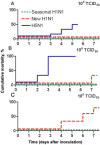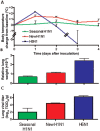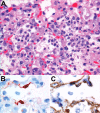Severity of pneumonia due to new H1N1 influenza virus in ferrets is intermediate between that due to seasonal H1N1 virus and highly pathogenic avian influenza H5N1 virus
- PMID: 20187747
- PMCID: PMC7110095
- DOI: 10.1086/651132
Severity of pneumonia due to new H1N1 influenza virus in ferrets is intermediate between that due to seasonal H1N1 virus and highly pathogenic avian influenza H5N1 virus
Abstract
Background: The newly emerged influenza A(H1N1) virus (new H1N1 virus) is causing the first influenza pandemic of this century. Three influenza pandemics of the previous century caused variable mortality, which largely depended on the development of severe pneumonia. However, the ability of the new H1N1 virus to cause pneumonia is poorly understood.
Methods: The new H1N1 virus was inoculated intratracheally into ferrets. Its ability to cause pneumonia was compared with that of seasonal influenza H1N1 virus and highly pathogenic avian influenza (HPAI) H5N1 virus by using clinical, virological, and pathological analyses.
Results: Our results showed that the new H1N1 virus causes pneumonia in ferrets intermediate in severity between that caused by seasonal H1N1 virus and by HPAI H5N1 virus. The new H1N1 virus replicated well throughout the lower respiratory tract and more extensively than did both seasonal H1N1 virus (which replicated mainly in the bronchi) and HPAI H5N1 virus (which replicated mainly in the alveoli). High loads of new H1N1 virus in lung tissue were associated with diffuse alveolar damage and mortality.
Conclusions: The new H1N1 virus may be intrinsically more pathogenic for humans than is seasonal H1N1 virus.
Figures





Comment in
-
Of ferrets and humans: influenza pathogenesis.J Infect Dis. 2010 Apr 1;201(7):976-7. doi: 10.1086/651133. J Infect Dis. 2010. PMID: 20187748 No abstract available.
References
-
- Trifonov V, Khiabanian H, Rabadan R. Geographic dependence, surveillance, and oOrigins of the 2009 iInfluenza A(H1N1) virus. N Engl J Med. 2009;361(2):115–119. - PubMed
-
- Chan M. Influenza A(H1N1). World Health Organization. http://www.who.int/mediacentre/news/statements/2009/h1n1_20090429/en/ind.... Published 29 April 2009. Accessed 25 August 2009.
-
- World Health Organization Pandemic (H1N1) 2009- update 62 (revised 21 August*2009) http://www.who.int/csr/don/2009_08_21/en/index.html.Accessed 25 August 2009.
Publication types
MeSH terms
LinkOut - more resources
Full Text Sources
Other Literature Sources
Medical

